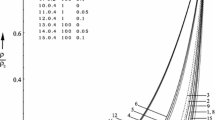Abstract
The motion of blunt bodies through two-phase media at high supersonic velocities is accompanied by strong heating of particles when they enter the shock layer. Because the ratio of the heating time of nonmetallic particles to the time of their thermal relaxation with the gas exceeds unity, large temperature gradients are developed in the particles, which are stressed and deformed and under the influence of the force and inertial loads they can then shatter, which significantly changes their force and thermal effect on the supersonic body. A special case of this problem — the shattering of ice particles in a shock layer under the influence of pressure forces — was investigated in [1]. In the present paper, the results of numerical calculations and known analytic solutions are used in the development of an approximate method for estimating the stresses that arise in spherical particles. Simple criteria are established for determining when the tensile stresses in the particles reach critical values above which the particles may shatter. As an example, the distribution of the temperature and stresses in silicon dioxide particles is considered.
Similar content being viewed by others
Literature cited
G. A. Simons, “Aerodynamic shattering of ice crystal in hypersonic flight,” AIAA J.,14, No. 11 (1976).
C. T. Crowe, “Drag coefficient of particles in a rocket nozzle,” AIAA J.,5, No. 5 (1967).
J. A. Fay and F. R. Ridell, “Theory of stagnation point heat transfer of dissociated air,” J. Aeronaut. Sci.,25, 73 (1958).
W. E. Nicolt, M. R. Wool, B. Laub, and N. A. Jaffe, “An investigation of hydrometeor shock layer interaction,” AIAA Paper, No. 318 (1976).
A. A. Samarskii, Introduction to the Theory of Difference Schemes [in Russian], Nauka, Moscow (1971).
The Standard Atmosphere. Parameters. GOST 4401-73 [in Russian], Moscow (1977).
R. E. Krizhizhanovskii and Z. Yu. Shtern, Thermophysical Properties of Nonmetallic Materials (Oxides) [in Russian], Énergiya, Leningrad (1973).
O. Zenkevich, The Method of Finite Elements in Technology [Russian translation], Mir, Moscow (1975).
B. M. Irons, “Economical computer techniques for numerically integrated finite elements,” Int. J. Num. Meth. Eng.,1, No. 2 (1969).
Yu. P. Andreev, R. V. Brailovskaya, and N. A. Voskresenskaya, Physicotechnical Properties of Quartz Glasses for High-Power Light Bulbs. Reviews of Electronics. Ser. Electrovacuum and Gas-Discharge Devices, No. 8 (407) [in Russian], TsNII Élektronika, Moscow (1976).
Encyclopedia of Inorganic Materials, Vol. 1, Glav. Red. Ukr. Sov. Éntsiklopedii, Kiev (1977).
Strength. Stability. Vibrations. Handbook, Vol. 1 [in Russian], Mashinostroenie, Moscow (1968).
A. V. Lykov, Theory of Heat Conduction [in Russian], Vysshaya Shakola, Moscow (1967).
Author information
Authors and Affiliations
Additional information
Translated from Izvestiya Akademii Nauk SSSR, Mekhanika Zhidkosti i Gaza, No. 1, pp. 66–73, January–February, 1981.
We thank V. G. Pchelkina for assistance in calculating the temperature fields.
Rights and permissions
About this article
Cite this article
Levin, A.L., Murzinov, I.N. & Tatarnikov, O.V. Thermal stresses and the shattering of solid particles in a shock layer. Fluid Dyn 16, 50–57 (1981). https://doi.org/10.1007/BF01094812
Received:
Issue Date:
DOI: https://doi.org/10.1007/BF01094812




